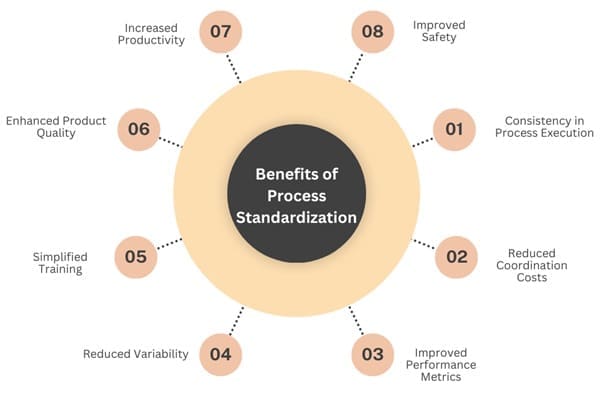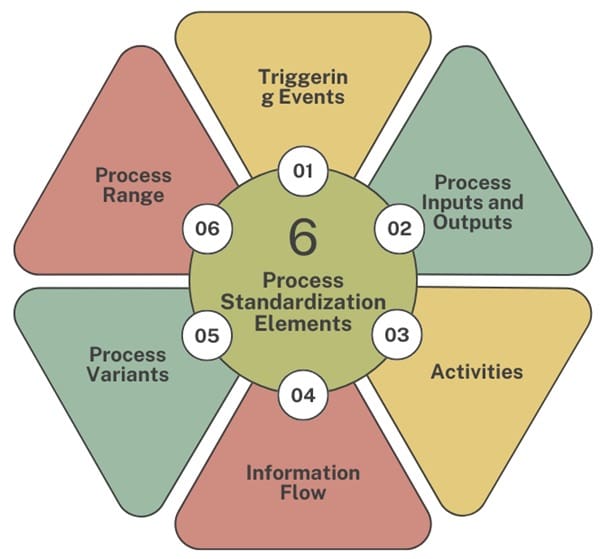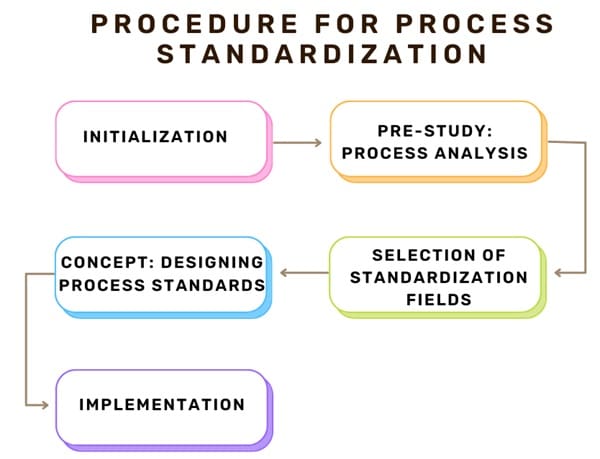Process standardization is a structured approach to streamline operations by aligning various processes under a consistent framework. At its core, it involves unifying processes to ensure uniformity, transparency, and efficiency across different parts of an organization. This standardization can apply to internal workflows, external transactions with customers, and collaborations with suppliers.
Businesses often implement standardization when they recognize that a uniform approach to their processes can solve existing quality or performance problems. Moreover, external factors like regulatory requirements or supply chain standards can also prompt organizations to adopt standardized processes.
Table of contents
What is Process Standardization?
Process standardization involves creating and implementing a consistent way of performing specific tasks within an organization. When multiple employees execute similar processes, variations in methods are likely, leading to inconsistent results, fluctuating quality, and training discrepancies. Establishing a standardized approach minimizes these issues, which, in turn, leads to improved product quality, increased productivity, and enhanced employee satisfaction.
Benefits of Process Standardization

Process standardization brings several advantages to organizations, primarily by optimizing the quality of operations, reducing time, and cutting costs. Some key benefits include:
- Consistency in Process Execution: Employees can easily follow standardized processes, reducing learning time and minimizing errors. This consistency ensures a predictable output, leading to improved product or service quality.
- Reduced Coordination Costs: Defined and consistent interfaces across departments or business units lower the need for constant coordination and negotiation, allowing teams to collaborate more efficiently.
- Improved Performance Metrics: Standard processes allow for easier tracking and comparison of performance across different units, making it simpler to identify areas for improvement.
- Reduced Variability: Standardizing work practices helps ensure that product characteristics and quality remain consistent, despite minor variations in equipment or environment. This consistency significantly minimizes the risk of defects and maintains uniform product standards.
- Simplified Training: With clear, step-by-step guidelines, new employees can quickly learn standardized tasks, reducing the training time and ensuring they follow the correct procedures from the start.
- Enhanced Product Quality: Standardized processes eliminate guesswork, enabling employees to complete tasks with high precision and consistency, which leads to improved product quality.
- Increased Productivity: By reducing unnecessary steps and providing clear instructions, employees can work more efficiently, completing tasks faster and with fewer errors.
- Improved Safety: Standardized work minimizes the chances of shortcuts or quick adjustments that might jeopardize safety. This is because processes undergo pre-evaluation for both safety and efficiency.
Key Considerations for Process Standardization
When embarking on process standardization, organizations must answer three critical questions:
- What Process Elements Will Be Standardized?
Every process consists of various components, including triggers, inputs, outputs, and activities. Therefore, the organization must determine which of these components to standardize and the extent of that standardization. - How Far Will Standardization Go?
The degree of standardization may vary. Some processes might require a high level of uniformity, while others might retain some flexibility to cater to unique needs. This decision directly affects the standardization of individual activities and determines the order in which they occur. - Where Will Standardization Be Implemented?
Standardization can be implemented within a single site or across multiple locations. In a multi-site scenario, the challenge is to ensure that employees in different locations perform the same activities with consistent quality, have access to the same information, and use the same resources.
Process Standardization Elements

A process consists of several elements that can be standardized. These include:
- Triggering Events: A process is initiated by a specific event, such as stock levels falling below a certain threshold. Standardizing triggers ensures processes begin at the right moment, improving efficiency.
- Process Inputs and Outputs: Inputs (e.g., raw materials or information) and outputs (e.g., finished products) are key elements of any process. Standardizing them ensures consistency in the resources used and the final products delivered.
- Activities: These form the core of a process and involve specific tasks or actions taken to transform inputs into outputs. To maintain uniformity across different processes or locations, you must standardize the sequence of these activities, or process logic. This ensures consistency in how tasks are executed.
- Information Flow: In many processes, information is passed from one stage to another. Standardizing the type and format of information ensures that employees in different roles or locations have the same understanding of the data.
- Process Variants: While standardization typically seeks to reduce variability, there may be cases where slight differences in processes are necessary, such as when dealing with customized products. The goal is to minimize these variants while maintaining flexibility where needed.
- Process Range: The range refers to the geographical or organizational extent of standardization. A process might be standardized in just one location or across several sites or business units. The broader the range, the more effort it takes to maintain consistency across diverse settings.
What is Standardized Work?
Standardized work defines the most efficient and consistent method for completing a task. It breaks down processes into specific work elements, organized in a sequence that employees can follow repeatedly. This approach reduces ambiguity, enhances productivity, and fosters a consistent level of quality across all tasks. It also serves as a documented reference for the best practices currently in use, helping to eliminate guesswork and inefficiency.
Steps to Standardize Work

- Record Current Practices: Begin by observing and documenting how tasks are currently performed. This may involve conducting work studies, including time studies and method studies, to capture the details.
- Analyze Data: Compare data on how different employees perform the task. This analysis can reveal inconsistencies in cycle times, sequencing, and more.
- Identify Wastes: Look for any non-value-added (NVA) activities, such as unnecessary motion or transport, and find ways to reduce or eliminate them.
- Optimize Work Elements: Develop an optimal sequence for each task element, incorporating best practices identified across employees.
- Consider Safety and Ergonomics: Ensure that the standardized process prioritizes safety and ergonomic practices, minimizing risks related to posture and repetitive movements.
Procedure for Process Standardization
You can treat implementing process standardization in an organization as a project that consists of clearly defined phases. These phases help ensure that the standardization initiative progresses smoothly and achieves its intended objectives.

1. Initialization
The process begins with the decision to standardize. This phase involves identifying the need for standardization, setting objectives, and forming a project team responsible for overseeing the initiative.
2. Pre-study: Process Analysis
Before implementing standardization, it is crucial to analyze existing processes to identify areas that could benefit from standardization. During the pre-study phase, we evaluate standardized processes for their effectiveness. Additionally, we identify processes that could benefit from standardization.
This phase also involves creating process maps to visually represent the flow of processes and their interactions. These maps help identify key processes that are critical to the organization’s success and thus prime candidates for standardization.
3. Selection of Standardization Fields
Not all processes need to be standardized. The next step is to prioritize processes based on their importance to the organization’s overall objectives. The processes that have the highest potential for standardization are selected for further development.
Factors to consider when selecting processes for standardization include:
- Reproducibility: Processes that can be easily replicated across different units or locations are strong candidates for standardization.
- Coordination Needs: Processes that involve high levels of coordination, both within and between business units, can benefit from the clarity that standardization provides.
- Centralization: Processes that companies outsource or centralize often become prime candidates for standardization. This is because consistent processes are easier to manage across different locations. By implementing standardization, organizations can enhance efficiency and ensure uniformity in operations.
- Integration with IT: Processes that require IT integration often need standardization to ensure that systems are compatible across different parts of the organization.
4. Concept: Designing Process Standards
Once you identify the key processes, the next step is to design the standards. These process standards outline the ideal way to conduct processes within the organization. Additionally, they provide clear guidelines that help ensure consistency and efficiency in operations. By establishing these standards, you create a framework that employees can follow to achieve optimal results.
They are typically based on either internal best practices or external benchmarks.
External reference models, like the Supply Chain Operations Reference (SCOR) model, provide a standardized framework for processes along the supply chain. Organizations can adopt these models or modify them to fit their specific needs. For example, Siemens used the SCOR model to develop its process standards for supply chain management.
5. Implementation
The final phase of the standardization project involves implementing the newly designed process standards across the organization. This implementation includes training employees, updating IT systems, and setting up mechanisms to monitor and evaluate the effectiveness of the new processes.
Challenges and Risks of Process Standardization
While process standardization offers numerous benefits, it also comes with certain challenges and risks. The most notable of these is the potential loss of flexibility. In industries where customers demand customized products or services, rigidly standardized processes may prevent the organization from meeting these individual needs.
Additionally, standardizing processes across multiple locations can be challenging, especially if different sites have varying levels of technology or resources. Employees may resist adopting standardized procedures because they are used to their own ways of working. However, overcoming this hesitation is crucial for ensuring a smooth transition to new processes.
Case Study: Process Standardization in a Footwear Company
A major footwear manufacturer faced inconsistencies across its production units. By standardizing processes across all units, they aimed to achieve consistency in quality and productivity. Through comprehensive work studies, they identified and eliminated inefficiencies, leading to a 25% productivity improvement and better manpower planning.
Value of Process Standardization
Process standardization not only drives internal efficiency but also increases customer satisfaction. By enabling easier outsourcing, enhancing the flexibility to adapt to regulatory changes, and improving technical interoperability, standardization strengthens the organization’s ability to respond to market dynamics.
Final Words
Process standardization is a powerful tool for organizations seeking to improve efficiency, reduce costs, and maintain consistent quality across their operations. By aligning processes across different parts of the organization, businesses can streamline operations, improve communication, and deliver better results.
However, the success of process standardization depends on a careful balance between standardization and flexibility. Organizations must ensure that they do not sacrifice their ability to meet customer demands or adapt to changing market conditions in their quest for standardization.
By following a structured approach and focusing on key processes, businesses can achieve the benefits of standardization while maintaining the agility needed to stay competitive in today’s dynamic marketplace.


















